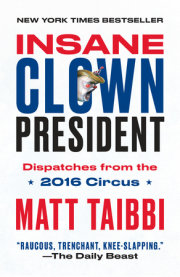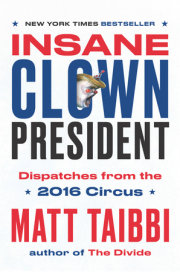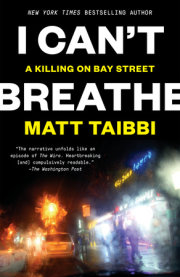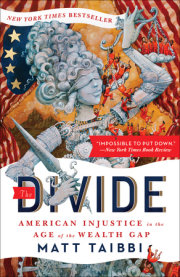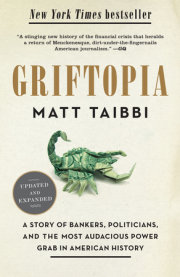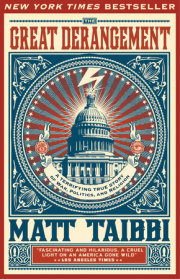Chapter 1
The Great Derangement Redux
Ten years before Donald Trump, I wrote a book about Middle America’s growing mistrust of government, the media and other mainstream forces. The thesis of the book was that we were moving toward a future in which facts would be increasingly irrelevant and people would gravitate more and more toward conspiratorial politics. This situation was fueled by the repeated failures of once-trusted institutions to respond to the frustrations of ordinary people.
I didn’t exactly see Donald Trump coming. But there were a lot of signs that the conditions were set long ago for the rise of a truly postfactual candidate.
From the introduction to The Great Derangement:
We were living through the last stage of the American empire. Historians consistently describe similar phenomena in past centuries. Great societies often collapse in the same way.
When the Bolsheviks finally broke through the gates of the Winter Palace, they discovered tsarists inside obsessed with tarot cards. When the barbarians finally stormed Rome in its last days, they found the upper class paralyzed by lethargy and inaction and addicted to the ramblings of fortune-tellers.
This, too, seemed to be the fate of America, viciously attacked by a serious enemy on 9/11 but unable to grasp the significance of this attack. Most of the country instead fled for consolation to the various corners of our vast media landscape, in particular seeking solace in the Internet, an escapist paradise for the informationally overwhelmed.
Trained for decades to be little more than good consumers, we had become a nation of reality shoppers, mixing and matching news items to fit our own self-created identities. We rejoiced in the idea that reality was not an absolute but a choice, something we select to fit our own conception not of the world but of ourselves. We are Christians, therefore all world events have a Christian explanation. We hate George Bush, therefore Bush is the cause of it all.
And directly feeding into this madness was the actual, real failure of our own governmental system, reflected in a chilling new electoral trend. After two consecutive bitterly negative presidential elections and many years of what was turning into a highly deflating military adventure in Iraq, the American public had reached new levels of disgust with the very concept of elections.
People no longer voted for candidates they liked or were excited by. They voted against candidates they hated. At protests and marches, the ruling emotions were disgust and rage. The lack of idealism, and especially the lack of any sense of brotherhood or common purpose with the other side (i.e., liberals and conservatives unable to imagine a productive future with each other, or even to see themselves as citizens of the same country), was striking.
Politicians, with their automated speeches and canned blather about “hope” and “change” and “taking the country back,” were now not only not believed by most ordinary people, but actively despised.
A parallel phenomenon was a growing lack of faith in the mainstream media on both sides of the spectrum. Conservatives and liberals alike accepted unquestioningly the proposition that the stories put out by network news broadcasts and major daily newspapers amounted to little more than a stream of untrammeled, insidious deceptions.
In the 2006 senatorial primary contest between the would-be Jimmy Stewart–esque do-gooder millionaire Ned Lamont and the archetypal Washington whore Joe Lieberman, the fault lines were outlined with crystal clarity.
The “People” boosted Lamont with blogs and YouTube broadcasts, while the entrenched political mainstream circled the wagons around Lieberman. The major news mags and dailies blasted the blogger phenomenon, and the likes of sanctimonious New York Times columnist David Brooks ascribed the antimedia bias to “moral manias” and a “Liberal Inquisition.”
On the right, similar fault lines were appearing. Whereas before conservative anger toward the “liberal media” had been usefully directed against the Democratic Party by Republican strategists, the failure of the Iraq war and also growing disillusionment on the part of Christians who had supported George W. Bush led more and more of those voters to seek out their own enthusiasms.
For the first time I started to see and hear people at Republican events who sounded very much like the dissidents on the fringes of American liberalism. The Ron Paul supporters who began to collect around the rallies of assembly-line establishment-blowhard candidates like Mitt Romney were almost indistinguishable from the followers of liberal candidates like Dennis Kucinich.
They were similarly against the war, similarly against the conspiracy of business interests that dominated Washington, similarly fed up with standard-issue campaign stumpery.
At these events I heard some of the same theories about “peak oil” and the nefarious influence of institutions like the Council on Foreign Relations and the Trilateral Commission that dominated 9/11 Truth rallies.
But they weren’t liberals. They were ex-Dittoheads and dropouts from the Republican revolution. The Ron Paul candidacy was an extreme example of outsider politics on the left and right merging.
I spent time down in Texas with a group of churchgoers who were loyal to an apocalyptic theory of world events, one in which 9/11 and the invasion of Iraq were part of an ongoing march toward a final battle between the forces of Satan and an army of God.
At the same time, I found myself involved, at times involuntarily, with the 9/11 Truth Movement.
The similarities between both of these groups is striking and should be clear to anyone who reads this book. Both groups were and are defined primarily by an unshakable belief in the inhumanity of their enemies on the other side.
The Christians seldom distinguished between Islamic terrorism and, say, Al Gore–style environmentalism. The Truthers easily believed that reporters for the Washington Post, the president, and the front-line operators of NORAD were equally capable of murdering masses of ordinary New York financial-sector employees.
Abandoned by the political center, both groups ascribed unblinkingly to a militant, us-against-them worldview, where only their own could be trusted.
What made them distinctly American was that, while actually the victims of an obvious, unhidden conspiracy of corrupt political power, they chose to battle bugbears that were completely idiotic, fanciful, and imaginary.
At a time when the country desperately needed its citizens to man up and seize control of their common destiny, they instead crawled into alleys and feverishly jacked themselves off in frenzies of panicked narcissism.
Time and again during the research for this book, I encountered people who acted not like engaged citizens looking for solutions to real problems, but like frightened adolescents, unaccustomed to the burdens of political power. People saw in the vacuum of governmental competence an opportunity not to take control of their lives, but to step in and replace the buffoons above with buffoon acts of their own.
They made elaborate speeches to no one in particular, as though cameras were on them, they dressed in Washington and Jefferson costumes, they primped and preened like they were revolutionaries, modern-day Patrick Henrys and Thomas Paines. And they got nothing done.
I was struck particularly by a meeting of 9/11 Truthers in Austin, Texas, in which a “discussion” of what to do about the conspiracy in Washington devolved into a speech-making session. A group of twenty-five to thirty Truthers filed into a little church on the outskirts of town and, led by a breezy, EST-counselorish moderator who enforced tolerance for the viewpoints of all, each participant got up and offered his or her own individual angry theory about the nature of The Conspiracy.
Some blamed the royals, others the bankers, others the Trilateral Commission, all blamed decades of Bush family iniquity, and one woman even talked about a conspiracy to hide the discovery of alien technologies at Area 51.
Everyone made his or her speech, and then the meeting was over with nothing accomplished except a decision to have another meeting.
Having seen all this, what I ended up trying to do in this book was describe the whole outline of the problem. Much of the book focuses on the insider game in Washington, from the corrupt response to Hurricane Katrina to both parties’ absurdly transparent attempts to deflect popular opposition to the Iraq war. At the same time I tried to describe the response to this nonfunctioning government across the country, on both the right and the left.
What I hope comes through is that the corruption of the system certainly has had consequences in the population, inspiring popular disgust and rage, with voters keenly understanding on some level anyway the depth of their betrayal.
But the form of the public response turns out to be a grotesquerie. It turns out that we’ve been split up and atomized for so long that real grassroots politics isn’t really possible.
We don’t respond to problems as communities, but as demographics. In the same way that we shop for cars and choose television programs, we pick our means of political protest. We scan the media landscape for the thing that appeals to us and we buy into it.
That it’s the same media landscape these new dissidents often reject as a false and misleading tableau dominated by corrupt interests turns out not to be problematic for many.
In some cases, like that of those Christians I spent time with in San Antonio, the trusted new figure, a preacher named John Hagee, turns out to be every bit the establishment Washington insider these would-be religious revolutionaries think they’re fleeing from.
In other cases, like that of the 9/11 Truthers, the radical canonical revolutionary tracts end up including thoroughly commercial mainstream entertainments like V for Vendetta and The Matrix (at different times I would hear both radical conservatives and liberals describe their political awakenings using the phrase “taking the red pill”).
In short, what sounds on the surface like radical politics turns out to be just another fracturing of the media picture, one that ultimately will result in new groups of captive audiences that, if experience is any guide, will ultimately be assimilated and electorally coddled by a political mainstream in reality bent on ignoring both sides.
For now, however, the situation going into the 2008 election looks grim. We have a population more disgusted than ever with our political system, one inclined to distrust the result no matter who wins the White House—and should the national election end up being a contest between a pair of full-of-shit establishment conservatives like Hillary Clinton and Rudy Giuliani, it will only confirm the worst fears of both sides and result in an even further bonkerization of the population.
Gone will be the good old days of neat blue-state/red-state hatred—a nicely symmetrical storyline that has always appealed to the Crossfire/American Gladiators sports-coverage mentality of the commercial media.
In its place, at least temporarily, will be a chaos of lunatic enthusiasms and dead-end political movements, with calls for invasions of Babylon and, on the other side, congressional investigations into nonexistent conspiracies . . .
When a people can no longer agree even on the basic objective facts of their political existence, the equation changes. Real decisions, even in the approximate direction of righteousness, eventually become impossible.
The Great Derangement is about a stage of our history where politics has seemingly stopped being about ideology, and has instead turned into a problem of information.
Are the right messages reaching our collective brain? Are the halves of that brain even connected? Do we know who we are anymore? Are we sane? It’s a hell of a problem for a nuclear power.
From Chapter One:
Out There, in states both blue and red, the People were boarding the mothership, preparing to leave this planet for good.
The media had long ignored the implications of polls that showed that half the country believed in angels and the inerrancy of the Bible, or of the fact that the Left Behind series of books had sold in the tens of millions.
But on the ground the political consequences of magical thinking were becoming clearer.
The religious right increasingly saw satanic influences and signs of the upcoming apocalypse. Meanwhile, on the left, a different sort of fantasy was gaining traction, as an increasing number—up to a third of the country according to some polls—saw the “Bush crime family” in league with Al-Qaeda, masterminding 9/11.
Media outlets largely ignored poll results that they felt could not possibly be true. For instance, there was a CBS News survey that showed that only 16 percent believed that the Bush administration was telling the truth about 9/11, with 53 percent believing the government was “hiding something,” and another 28 percent believing that it was “mostly lying.”
Then there was a stunning Zogby poll taken just in advance of the 2004 Republican convention that showed that nearly half of New York City residents—49.3 percent—believed that the government knew in advance that the 9/11 attacks were coming and purposely failed to act.
Voters didn’t just distrust the government’s words and actions. By 2007 they also had very serious doubts about their government’s legitimacy.
Successive election cycles foundering on voting-machine scandals had left both sides deeply suspicious of election results. A poll in Florida taken in 2004 suggested that some 25 percent of voters worried that their votes were not being counted—a 20 percent jump from the pre-2000 numbers.
Even more damning was a Zogby poll conducted in 2006 that showed only 45 percent of Americans were “very confident” that George Bush won the 2004 election “fair and square.”
The most surprising thing about that last poll was the degree to which the distrust was spread wide across the demographic spectrum. That 71 percent of African Americans distrusted the 2004 results was perhaps not a surprise, given that black voters in America have been victims of organized disenfranchisement throughout this country’s history.
But 28 percent of NASCAR fans? Twenty-five percent of born-again Christians? Thirty-two percent of currently serving members of the armed forces?
These are astonishing numbers for a country that even in its lowest times—after Watergate, say, or during Reconstruction—never doubted the legitimacy of their leaders to such a degree.
And if distrust of the government was at an all-time high, that was still nothing compared to what the public thought of the national media. Both the left and the right had developed parallel theories about the co-opting of the corporate press, imagining it to be controlled by powerful unseen enemies, and increasingly turned to grassroots Internet sources for news and information.
In the BBC/Reuters/Media Center’s annual Trust in the Media survey in 2006, the United States was one of just two countries surveyed—Britain being the other—where respondents trusted their government (67 percent) more than they trusted national news reporters (59 percent). A Harris poll that same year showed that some 68 percent of Americans now felt that the news media were “too powerful.”
The country, in other words, was losing it. Our national politics was doomed because voters were no longer debating one another using a commonly accepted set of facts. There was no common narrative, except in the imagination of a daft political and media elite that had long ago lost touch with the general public.
Copyright © 2017 by Matt Taibbi. All rights reserved. No part of this excerpt may be reproduced or reprinted without permission in writing from the publisher.



